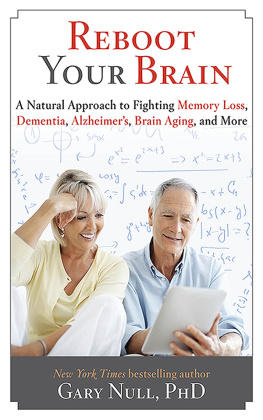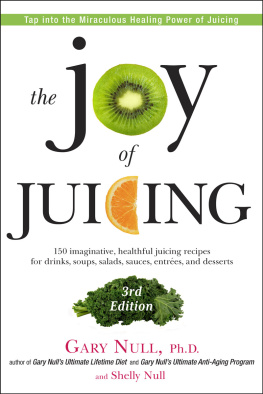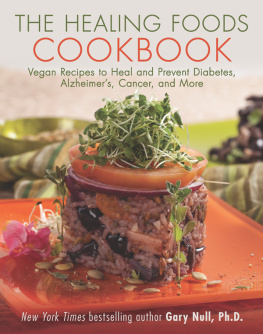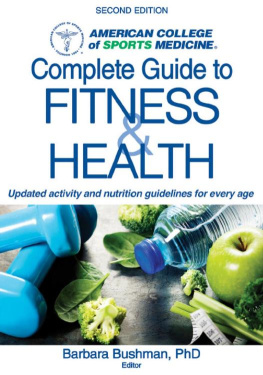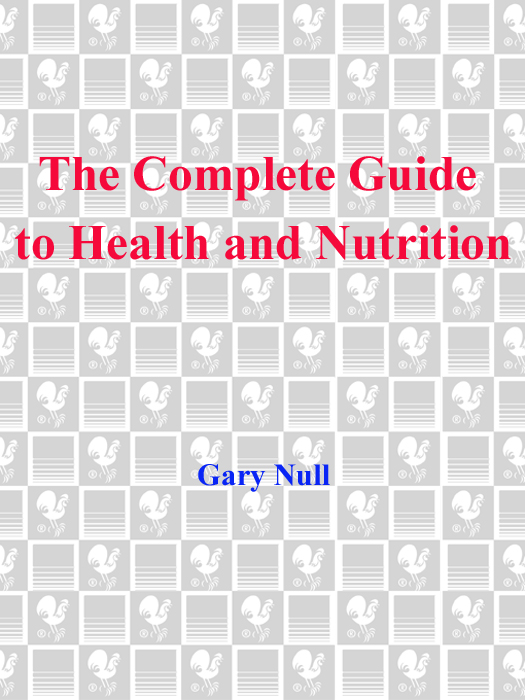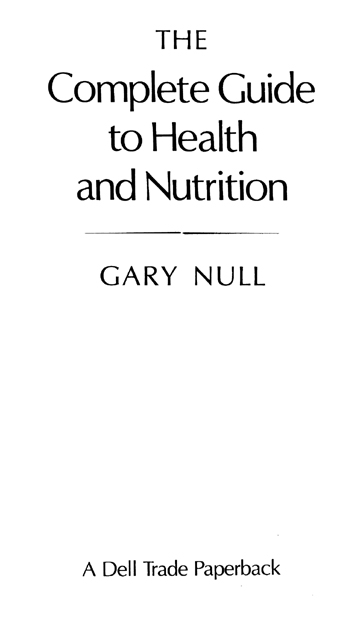A Dell Trade Paperback
Published by
Dell Publishing
a division of
Bantam Doubleday Dell Publishing Group, Inc.
1540 Broadway
New York, New York 10036
Recommended Heart Rates During Exercise from Fit or Fat by Covert Bailey.
Copyright 1977, 1978 by Covert Bailey. Reprinted by permission of Houghton Mifflin Company.
Copyright 1984 by Gary Null
All rights reserved. No part of this book may be reproduced or transmitted in any form or by any means, electronic or mechanical, including photocopying, recording, or by any information storage and retrieval system, without the written permission of the Publisher, except where permitted by law. For information address: Delacorte Press, New York, New York.
The trademark Dell is registered in the U.S. Patent and Trademark Office.
eISBN: 978-0-307-41950-7
Reprinted by arrangement with Delacorte Press
v3.1
CONTENTS
INTRODUCTION
Gary Nulls Complete Guide to Health and Nutrition is the most complete and authoritative popular work of its kind. Five years in the making, it explains fully and simply the basics of health and nutrition: whats in the food we eat, how it affects us, and how we can make ourselves healthier through good nutrition.
The Complete Guide is unique in the thoroughness and objectivity of its viewpoint. Nutrition arouses strong emotions in many of us, and some researchers let their emotions guide them toward one or another particular philosophy of health: alternative medicine, holistic therapy, New Age beliefs, or the orthodox, traditional methods of health care. And many of these adherents let their presentation of facts be guided by their opinions.
Gary Null lets his opinions be guided by the facts. Avoiding all prejudiced viewpoints, he gathers every important piece of research on every important subject: vitamins, minerals, fats, carbohydrates, protein. Thousands of books and articles have been read, and more than 2,000 experts in diverse fields have either been consulted or interviewed in establishing the real facts of each particular problem. From this mountain of material Gary Null has distilled a concise, accurate statement of everything thats known about health and nutrition. To get the same wealth of information you would have to consult thirty to fifty separate books in the same field.
But the Complete Guide is not simply a reference book; it is a source book for a healthier life. When all the facts support a particular position on some issue in diet and nutrition, Gary Null does not hesitate to state that position strongly and back it up with sound practical advice. He confronts all the complex health issues facing us today and answers the questions his readers will be asking. How much protein do I need? Is vitamin E really effective in treating heart disease? Which vegetables supply the highest fiber content? Questions like these are answered not only in authoritative explanations but in valuable charts and diagrams as well. And sensitive issues such as sugar and cholesterol are presented not only as matters of health but as economic and political issues.
With Gary Nulls Complete Guide to Health and Nutrition, readers can stop guessingand worryingabout whats in the food they eat. They can get all the knowledge amassed by scientific research, and learn how to apply that knowledge to their own lives.
Martin Feldman, M.D.
New York City, 1984
PROTEIN
And God said, Behold, I have given you every herb bearing seed, which is upon the face of all the earth, and every tree, in the which is the fruit of a tree yielding seed; to you it shall be for meat.
Genesis
1:29
If I were to do a word association test with you and I mentioned the word protein, the first thing to come to your mind would probably be meat.
After the term meat, no doubt you would mention chicken, hamburger, steak, vealthe flesh of an animal.
If I said, high-protein diet, most likely you would imagine lots of red meat would be included.
If you are like most people, you probably have no idea how many grams of protein you need every day. You may have heard of the concept of complementing proteins but are probably vague about how its done. And if you are like most people, you have no idea how to evaluate the net protein utilization of a particular food.
If you had to eliminate meat from your diet, would you be able to obtain enough quality protein?
In America today, we are faced with the notion that protein is synonymous with meat, our primary source, and that without a substantial amount of meat in the diet, we would be suffering from gross protein deficiencies. Many people believe they must eat meat every day, often three times a day. Theyll consume ham or bacon for breakfast; luncheon meat such as salami, bologna, frankfurters, or hamburgers for lunch; and roast beef, fish, chicken, or steak for dinner. If you are an athlete, you will almost surely at some time in your training take high-protein supplements.
Serious problems arise as a result of the gross ignorance and misinformation prevalent on a subject so essential for good health. Very few people know what protein truly is, why we need it, what its best sources and its worst sources are, what are the toxic forms of protein and the toxic by-products associated with it, what is the most easily digested protein, how we should combine proteins, and how much protein we need as we age.
Family No. 1: The Typical American High-Protein Diet
If I were to ask you whether a seventeen-year-old and sixty-year-old woman require the same amount of protein, what would you say? As a point of fact, if you went into the average persons home and joined their family for dinner, you might sit down at the table with a mother, father, daughter, son, and possibly a grandparent. In all probability, all of them would receive the same amount of a protein food. This would usually be a meat/flesh item. But clearly the daughter and son, since they are growing, have a greater need for quality protein; the wife, who weighs fifty pounds less than her husband, has less need for protein than her husband; and the grandparent has still less need due to both age and the difficulty of digesting protein. Instead of offering each person the type and quantity of protein he or she needs for optimal health, we give protein in the same amount to every person irrespective of age or special circumstance.
When you are going in for surgery, when you are pregnant or lactating, or when you are under stress, exercising regularly, or growing, you require more protein than under normal conditions.
The average persons lack of knowledge on protein is as great as their ignorance concerning carbohydrates and the distinction between the empty calories from white sugar and the much better utilized calories from, for example, brown rice.
We must now take a careful look at protein to see what role it plays in our life.
To many Americans, good nutrition means protein. They know they need something called protein. As a result, they usually take too much. Most of our protein requirements could be met with about six ounces of complete protein a day. Its been estimated that the average American consumes upward of 100 grams of protein a day. That may be almost double what we actually need.
Lets sit down for dinner with that typical American family mentioned earlier. They associate meat with strength, well-developed musculature, and an active, hearty life. They think of their heroesthe athlete, the cowboy, the rugged outdoorsmanas meat eaters. And they believe the strength of these mythlike figures somehow derives from regular consumption of beefsteak.


